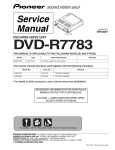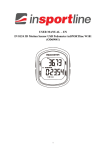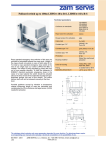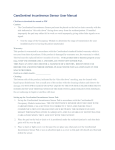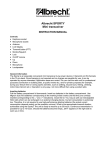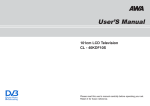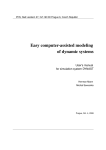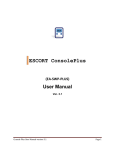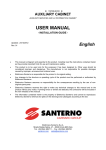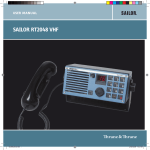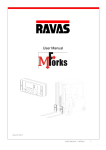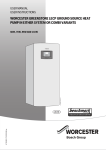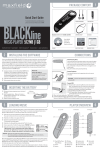Download A_Automatizace_Automatizační - ZAM
Transcript
The right choice in sensors Conveyor belt operation can be divided into two areas according to the definition of the environment the so-called “heavy duty” and “light duty”. This designation applies only to the simpler division of the sensors mentioned below. The exact environment specifications must be known prior to selecting the sensors. Frequently it can be found in the project documentation or in the auditor's report. If you do not have this classification or if it does not comply with the new standards, it must be made prior to realizing the project documentation for automation. RDP 444 Automation Unit Description: Aberration sensors Heavy duty Light duty Sensor VSP-3B A A Sensor LHPE-10/2-LP Sensor ET-4T A N Z A Heavy duty Light duty Switch LHPEw-10/2-B-S A Z Switch LHPEw-10/2-BSL-S A Z Switch LHPEw-10/2-BSR-S Switch SNS 12 Switch Lifeline 4 A N N Z A A Sensor type Pull-wire switches Heavy duty It is a characteristic for the outdoor environment with climatic influences where heavy material is produced and transported and where heavy machinery is used. The technology in such duty is continuously subject to damages caused by the material being transported or by machine manipulation, by dust or mud, by temperature changes, and by the sturdiness of the whole technology designed for the relevant environment. “Heavy duty” can mean all logging systems, manufacturing technologies for mineral raw materials, etc. Light duty It is a designation for operation at constant temperature inside factory buildings, where light material is transported using small conveyors. Brute force is not necessary here and environmental characteristics low dust nuisance, cleanness, etc. will guarantee long service life of the technology. Conveyor production in car factories and electronics factories, production of plastic moldings etc. can be considered “light duty”. Typ spínaèe Glossary: A - we recommend for this application excellent solution M -possible to use for this application, but all parameters must be checked N- not suitable, will not work under given conditions, definitely short service life Z- will work reliably, but this solution is unnecessarily expensive The automation unit controls one conveyor belt drive by means of a control network. It is designed to ensure its wide application possibilities for different drives. Its modular design enables quick compiling with regard to the given drive power. The control unit has terminals for connecting the necessary sensors including inputs for technology measurement. Safe start and stop of the system will be achieved by proper sensor mounting on the conveyor belt and by connecting to the relevant terminals according to the manual. The control logic and the status control are programmed in the control system which can recognize the connected sensors and determine the trace mode. This unit can run in an autonomous mode without the control network. All status and starting records are made automatically and can be listed on site by means of a computer. The unit is adapted for relay operation and control as well. It means that it can be inserted in the middle of the conveyor line and start and/or stop commands can be performed from the contactor room by means of relay contacts. This possibility serves for the gradual recovery of the conveyor system without a radical disturbance or blocking of the transport. Total investment can be spread over a longer time period. The unit is comprised of a control unit MODUL IQ and a power part MODUL SJW. Both parts are designed as one distribution field and they are delivered in a distribution board with high protection as standard equipment. The distribution board can be delivered with more units as an economical solution. This version can be used where conveyors are close to each other. All conveyor status information from the sensors is brought to the control part. The safety loop directly controls the power part and it will transmit the information about emergency stopping to the control unit as well. The control unit will provide this command for other devices and will inform the operating staff by means of the control network. The power supply is provided by two cable ducts. The power supply for the drive can be the often used 3 x 500V/50Hz and the power supply for the control 230V/50Hz, preferably with a back-up power supply. Double feeding will increase the quality of control in terms of disturbance and it will enable better system check (line operation can be simulated without unnecessary starting of the drives). Rpm sensors Heavy duty Light duty Sensor SHR 2, magnet MHR 2 A Z Sensor SHR 3, magnet MHR 2 Sensor XSA11373, magnet MHR 2 Sensor XSA12373, magnet MHR 2 M N Z A N A Heavy duty Light duty Sensor type Transfer sensors Sensor type Sensor RHP 5 A N Sensor UMV1 Sensor UMV2 Sensor K1 BOS-21, probe BOS-4T A A A A N A The catalogue sheet contains only some parameters important for your decision. For planning always require a corresponding user manual and eventually a technical consultation on the possibilities of use. ISO 9001 : 2001 V01 ZAM-SERVIS, s.r.o. Ostrava, tel.: +420 596 135 422, email: [email protected] www.zam.cz ISO 9001 : 2001 V01 ZAM-SERVIS, s.r.o. Ostrava, tel.: +420 596 135 422, email: [email protected] www.zam.cz RDP 444 Automation Unit Software control of the conveyor paths Description: The RDP 444 automation unit is programmed by means of the SWRDP 444 utility program or by means of visualization software with a specific programmed application. The SWRDP 444 program This program is designed for an automation unit engaged in the system without visualization software. Configuration of the unit, parameters for input data from the sensors, and control methods (outputs), where dependences on other units within the network are defined, can be adjusted here. It is also possible to read the archived unit status data from the control part. This software is not intended for line control and cannot be used for this purpose. The lines (units) are started by means of the voltage input at the terminals for the “start” command and by disconnecting from the command input for the “stop” command. If more units are linked in a network, the “start” or “stop” commands will be transferred to the other RDP 444 units after time constants and modes are defined. Information about emergency stopping or stopping for other reasons (e.g. slipping) is transferred within the network between the units as well. Information about conveyor run and/or breakdown is available at the dry output contact terminals which can then be used for the control of the continuing conveyor path without RDP 444 control. The figure above shows the schematic diagram for an optimum connection of the RDP 444 unit. The most suitable position of the unit is close to the conveyor drive. The position is determined by the cabling for the drive. The sensors are connected according to the diagram; the longest path is that of the rpm sensor which will be installed on the angle pulley. If the drive is on the opposite side of the conveyor than in the diagram, the transfer sensor will represent the same distance. ISO 9001 : 2001 V01 This situation is usually solved by one cable. The pull-wire system and the aberration sensors will be adapted according to the specific situation. All cabling is positioned with reference to disturbance safety and theft protection. The automation unit is delivered for one drive in one distribution board. For conveyor combinations with drives close to eachother the automation unit will be located on one distribution board. ZAM-SERVIS, s.r.o. Ostrava, tel.: +420 596 135 422, email: [email protected] www.zam.cz pre-programmed procedures if any crash should occur. For example it can switch off the path with material before the crash point and it will leave the path after this point to transport the remaining material. The intervention can be performed manually by the operating staff by means of controls. This example does not show emergency stop! In addition to conveyor path and machine technology control, the program will make an automatic back up of all operations executed and it will archive information about conveyor or other technology conditions from the individual RDP 444 units. This data can be used for statistical calculations of the number of faults, their types (e.g. slipping), time they happened, etc. These calculations can serve as a basis for subsequent measures against similar faults. Visualization software Visualization software is used for control and regulation of the whole technology. The most suitable program for visualization is Control Web. However, we are able to carry out visualization in other programs if required. Visualization means graphic representation of the technology, where important machine parts status data are shown. They are standardly displayed as simple drawn objects. In addition to that, 3D animation or film sections are available for better lucidity. In the visualization, active buttons designed to control the technology or to display details of the individual parts are used. The visualization software is installed in the standard or the industrial computer. The computer is connected to the RDP 444 automation unit network and to the control system network for other technologies (sieve control, trouser slippage, etc.) through a module with a converter. Primary configuration of the unit and of the parameters for input information from the sensors is made through this connection. Its control is defined in the relevant visualization application and therefore it is not necessary to enter these parameters. The start and stop commands are given through the network from the computer. The program can instantly check the conveyor condition and it will display the location of the fault and intervene automatically according to ISO 9001 : 2001 V01 ZAM-SERVIS, s.r.o. Ostrava, tel.: +420 596 135 422, email: [email protected] www.zam.cz


